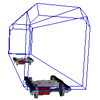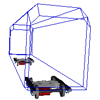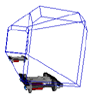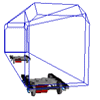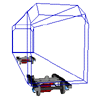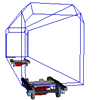UM Base
UM Base
The Module of Linear Analysis
The module of linear analysis is a built-in part of the basic UM version.
The module provides the following facilities:
– linearization of equations of motion in the equilibrium position;
– calculation of natural frequencies and animation of natural modes of the system;
– plotting the root locus;
– calculation of the critical velocity of railway vehicles (available for railway version)
– searching equilibrium positions of a system;
Searching equilibrium positions
Equilibrium position of a mechanical system is an obvious thing for the simplest systems only, for example, in the case of a mass supported by a spring. The equilibrium equations of complicated systems are nonlinear and have to be solved numerically. In general, several equilibrium positions of the system exist; ones of them can be steady-state positions while others can be not. Besides, some equilibrium positions can be undesirable for the researcher. And it is impossible to investigate automatically, whether the found equilibrium position is a desirable one. UM user has a possibility to make the system closer to the position by changing or fixing some of generalized coordinates of the system.
There is an opportunity to perform calculation of equilibrium position of a system repeatedly changing any parameter of the system given as a symbol. As a result, the dependence of equilibrium coordinates on this parameter can be plotted.
Linearization of equations of motion
UM can automatically linearize the equations of motion of the system near any found equilibrium position. The mass, stiffness and damping matrices of the linearized system are calculated and used in further investigations. However, these matrices itself can be useful for the user and be imported to any external program package.
Natural frequencies and modes
UM is able to analyze a small motion of a system near the found equilibrium position. Natural frequencies of vibrations and corresponding eigenvectors needed for the animation of natural modes are calculated. Modal analysis helps to determine, whether the given equilibrium position is steady-state or not: in the latter case, the values of some frequencies will be expressed in terms of imaginary numbers. Calculation of natural frequencies and modes is possible in the two forms: without consideration of all the resistance forces (free vibrations) and with taking into account that forces (damped vibrations). First six natural modes of the model of a metro car are presented
Plotting the root locus
The root locus allows the user to determine visually, whether the equilibrium position of the system is steady-state. The root locus is a trajectory of eigenvalues of the system on a complex plane, which corresponds to changing of any parameter of the system.
Calculation of the critical velocity of railway vehicle
This facility of the module of linear analysis is available in common with the railway module only. It is known that the motion of all railway vehicles becomes unstable if the velocity overcomes the critical one. To determine the critical velocity, the equations of motion of the vehicle are linearized with taking into account the forces that are specific for railway vehicles, namely the rail-wheel interaction forces (creep forces).
